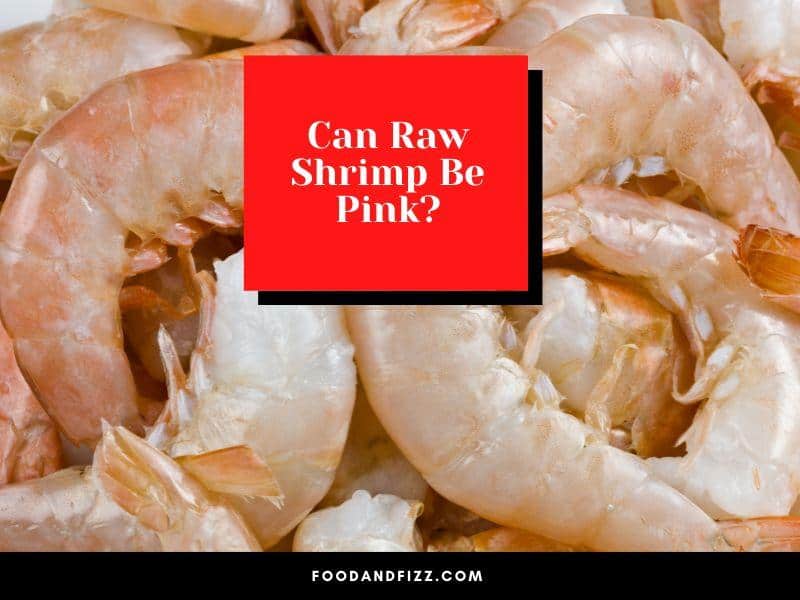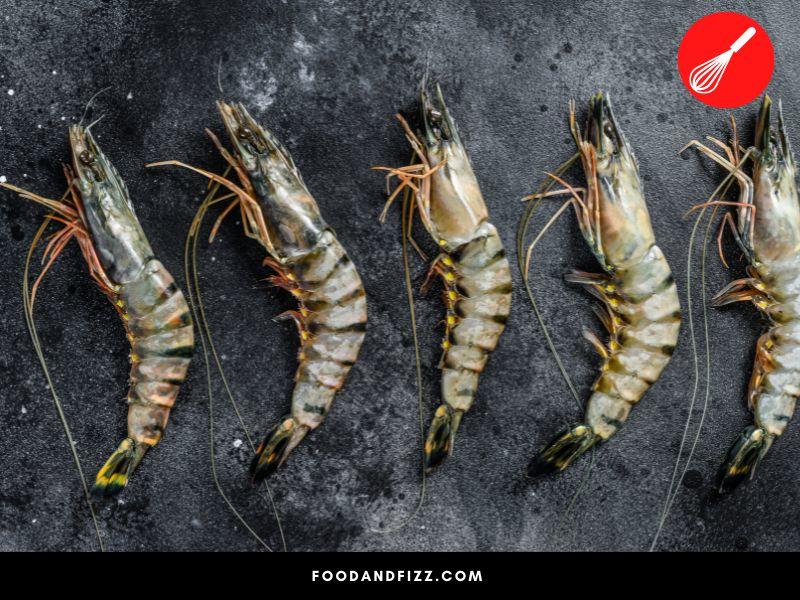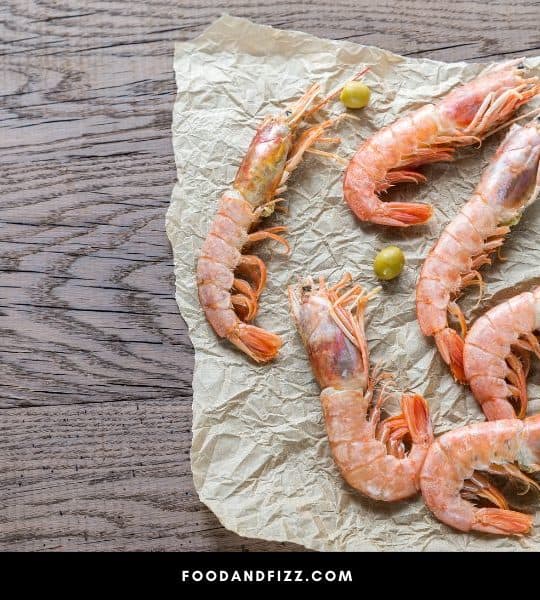Shrimp is one of the most popular and beloved seafood in the world and one of the most favored and heavily consumed in the US.
With their lovely pink color that adds visual appeal to food, they can be served in a variety of dishes from salads to appetizers to main dishes, and can be baked, grilled, fried, and cooked in many different ways.
When uncooked, their colors usually start off as translucent white to a grayish-green, and when cooked, they turn into that characteristic pink color that they are known for.
But is this always the case? Can raw shrimp be pink?
Can Raw Shrimp Be Pink?
Raw shrimp can be pink if it is one of the varieties of shrimp known collectively as pink shrimp. However, they look very different from the pink hue of cooked shrimp. Other than those varieties, the color of raw shrimp can range from translucent to white to tints of grayish-blue or green, which turn pink once they are subjected to heat.

Can Raw Shrimp Be Pink?
Your raw shrimp can be pink if it comes from any of the variety of shrimp known as pink shrimp.
Pink shrimp are generally cold-water and cold-weather shrimp, with the most known ones residing in the North Atlantic and North Pacific oceans.
They are smaller, sweeter, have a milder flavor, and can be sold fresh or frozen (although more commonly, frozen). They can have a pinkish or reddish hue when raw, but it looks very different from the pink hue of cooked shrimp.
Types of Pink Shrimp
We’ll briefly look at some of the known varieties of pink shrimp below.
Northern Shrimp
This species of pink shrimp are found in the northern cold waters of both the Atlantic and Pacific oceans, although the ones found in the Pacific ocean are sometimes considered to be a different subspecies due to slightly different characteristics.
Northern shrimp from the Pacific are also called Alaskan pink shrimp and spiny shrimp and are uniformly pink in color without any banding. They are sweet, mild flavor, and have a softer texture.
Northern shrimp, because of their smaller size, is also what’s known as “salad shrimp”. They are normally sold frozen.
Northern shrimp populations have also been found to be decreasing, due to warming of oceans and an increase in ocean predators.

Maine Shrimp
This is a type of Northern shrimp that is caught and sold off the coast of Maine and is just a regional name for Northern shrimp.
Oregon Pink Shrimp
A variant of the Northern pink shrimp, Oregon pink shrimp are different in that they are MSC-certified and sustainably sourced and caught.
They are commonly marketed as “cocktail shrimp” and “salad shrimp”. The peak season for fresh is April to October but can be found frozen all year round.
Gulf Pink Shrimp
Found primarily off the coast of Florida, this variety of pink shrimp prefers warmer waters and is bigger than their cold-water counterparts.
They are the biggest among the gulf shrimps (they can grow up to 11 inches long!) and are sweet but have a milder flavor profile. They are sweet with a bouncy texture.
Southern Pink Shrimp
Also known as Brazilian pinks, these types of pink shrimps are mostly found in waters from Brazil to Cuba.
There are other varieties and sub-varieties of pink shrimp and while they are called pink shrimp because their colors have a pink hue to them, they look very different from the pink color that we associate with cooked shrimp.

Other Types of Shrimp
Some other popular species of shrimp include:
Brown Shrimp
One of the most commonly harvested shrimp species, they get their brown color from eating foods rich in iodine.
They can grow up to 7 inches long, are bold and briny in flavor, and can be found anywhere from the North Atlantic to the Gulf coast, all the way down to the Yucatan peninsula.
They are good for hearty seafood dishes like stews and curries and in dishes like jambalaya.
White Shrimp
Another common shrimp variety in the U.S., white shrimps are very versatile and can be used in a variety of dishes due to their ability to absorb different types of flavors and sauces.
They have a mild and sweet flavor and do well in different cooking preparations.
Rock Shrimp
Rock shrimps are named as such because of their extremely hard shells, and they used to be discarded when caught until a machine was invented in the 1960s that allowed them to be peeled properly and deveined.
Their average size is 2-3 inches, and their texture is meaty and buttery. They have been compared to lobsters both in taste and appearance. Most of the ones in the U.S. have been caught around Florida.
Tiger Shrimp or Tiger Prawns
Technically not a shrimp but a prawn (completely different species!) and mostly found in Asia, Australia, and Africa, Tiger Prawns get their name from the characteristic black stripes found on their shells that turn a bright red when cooked.
They are mostly commercially farmed. They can grow up to 13 inches long and are currently the largest type of shrimp that humans sell and consume.
Farmed tiger prawns have a milder flavor compared to wild-caught ones, and their meat is soft and tender. If you are curious to know what prawns taste like, check out What Do Prawns Taste Like.
There are many other shrimp varieties other than the ones we mentioned above, each with its own specific characteristics, flavor profiles, and specific culinary uses, without a doubt making shrimp one of the most versatile seafood we can use.

Why Is Cooked Shrimp Pink?
Raw shrimp is normally white, translucent, or a grayish-green or blue color (Pink shrimp can be pink or have a red or orange accent on their bodies but it looks very different from the pink color we are referring to when we think of shrimp.).
Once they are subjected to heat, however, their color changes, and they turn pink, due to the release of a compound called astaxanthin.
What is Astaxanthin?
A carotenoid is a type of pigment with red, orange, or yellow hues that give certain fruits and vegetables their characteristic color. It is responsible for example, for the orange color in carrots or the red color in tomatoes.
Astaxanthin is a type of red pigment or carotenoid found in the exoskeleton or outer shells of shrimp and other crustaceans like lobsters and crabs.
While the shrimp is still raw, astaxanthin remains hidden and bound to proteins called crustacyanin, which doesn’t allow them to display their natural pigment.
When the shrimp is subjected to heat, these proteins denature and uncoil because they are not heat-stable.
As the bonds dissolve, astaxanthins are freed and released, causing the shrimps to turn a shade of pink. This is also the same reason why lobsters turn a bright red as they cook.
Interestingly, it is also the reason why flamingos are pink. In a true case of “you are what you eat”, flamingos are pink because they mostly eat a diet of algae and shrimp.
They don’t cook their shrimp but their digestive system metabolizes the crustacyanins found in shrimp which causes the anthoxanthins to be released, thus turning their feathers pink.
The pink hues in pink shrimp do not look like the hues of cooked shrimp, and it is important to know the difference as eating raw shrimp can have adverse health effects.

How Do I Know If My Shrimp is Cooked?
Shrimp, especially the smaller varieties, do not take very long to cook. This is why there is a tendency to overcook them.
While it is understandable to want to be cautious in cooking any type of seafood because of the risk of food-borne illnesses, overcooked shrimp can also be tough and rubbery, and won’t be enjoyable to eat.
Here are two ways to know that your shrimp is done.
1. Color
Shrimp is cooked when it has turned a pink color and the flesh is white and opaque, not translucent.
If the flesh is still translucent, continue cooking, but make sure to remove them from heat when they are just almost done –not completely done– as they will continue to cook for several minutes even at room temperature.
2. Temperature
Most cooks agree that cooking to a temperature of 120°F is sufficient for shrimp for optimum taste and texture.
However, if you are immunocompromised or have a weakened immune system, consider cooking to the USDA-recommended temperature of 145 °F for seafood and shellfish.
Risks of Eating Raw or Undercooked Shrimp
Raw or undercooked shrimp puts you at risk for bacteria and pathogens that can cause food-borne illnesses and can cause symptoms like nausea, diarrhea, vomiting, fever, and stomach pain.
In otherwise healthy individuals, these symptoms may resolve within a few days although depending on the case and the person, may turn potentially serious.
In individuals with weakened immune systems though, this may cause a more serious illness, which is why these individuals are often advised to avoid raw seafood.
Read next if you can eat shrimp with white spots.
Frequently Asked Questions to Can Raw Shrimp Be Pink?
Why is My Raw Shrimp Pink?
Raw shrimp can be pink depending on the variety of shrimp, but they will still look different from the pink hue of properly cooked shrimp.
Can You Eat Raw Shrimp?
When carefully and properly prepared like in reputable sushi and sashimi places, you can eat raw shrimp if you are a healthy individual. However, it still does not completely guarantee that the risks associated with consuming raw seafood are eliminated.
What Does Raw Shrimp Look Like?
Raw shrimp is usually translucent, white, with a grayish hue. Other varieties like tiger shrimp would have black stripes, while pink shrimp would have shades or accents of red or pink in their shells.
Conclusion to Can Raw Shrimps Be Pink?
Raw shrimps are usually white, translucent, and gray-blue or green in color but they can be pink or have pink hues if they are a variety of pink shrimp.
Pink shrimp though, even when raw, do not resemble the pink hue of properly cooked shrimp, and should not be confused as being cooked.
Making sure that your shrimp is sourced from reputable sources, is handled and stored properly, and is properly cooked ensures that we are not putting ourselves at risk for food-borne illnesses.
Consuming undercooked or raw shrimp can expose us to bacteria or viruses that can lead to potentially serious health issues.

